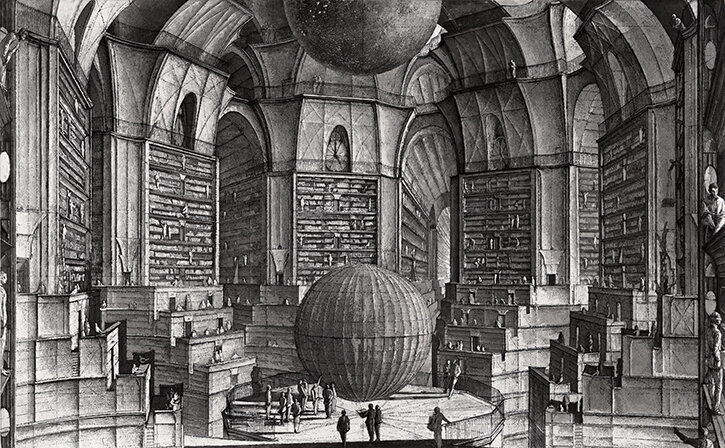The Library of Babel: From Gibberish to Defined Design
“The Library of Babel is a short story written originally in Spanish by Argentine author Jorge Luis Borges. The premise of the story is that there exists a library of infinite size, filled with an infinite amount of books. The twist however is that each book is 410 pages of a completely random set of letters, spaces, periods, and commas. ”
Fig 1. Illustration of Library of Babel
The library theoretically contains the sum knowledge of all mankind and every book ever written. It contains the Bible, the works of Shakespeare, a record of the past, and a complete prediction of the future. Unfortunately, the library is useless because pretty much 100% of the books are just gibberish.
I believe this story captures the infinite nature of design. There are an infinite number of geometries, materials, processes, and configurations for designers to choose from. The design space is just like the Library of Babel in that basically any design is just a combination of already existing shapes and materials. Among these infinite combinations are millions of poor designs and much fewer desirable designs. Stumbling on the right design by accident is both hard and improbable.
Unlike the Library of Babel however, designers aren’t left to random selection. Designers use a variety of tools and activities to select a design that successfully meets an objective. There might not be a perfect design, but there are a lot of good designs. The challenge designers are faced with is choosing the best design they can under a specific set of constraints, requirements and resources.
How can designers choose a good design, and what tools do they have?
There are a wide variety of tools including brainstorming, prototyping, modeling, personal experience, and the knowledge of others. A skilled designer knows which tools are best for which situation as well as the order to use them, and the amount of emphasis and time to allocate to them.
The purpose of these tools is to narrow down an infinite set of choices to one desirable design. Some decisions may be inconsequential, and require less attention, while others may be vital and require more thought. Deliberately making these choices is what separates design from merely building, tinkering, or throwing something together. Engineering gives product designers many useful tools to choose from, especially relating to the physical and mechanical properties and behaviors of a product.
The Library of Babel includes the works of Shakespeare, but it also includes a near infinite collection of books that appear to be the works of Shakespeare but aren’t quite correct. Some might be a letter or two off, while others might start well for the first hundred pages then degenerate into complete gibberish. Every detail is chosen by the designer deliberately, or it exists as a random or semi-random decision that might not be favorable to the desired outcome.
The repeated use of design tools and activities, as we often do in product development, helps designers ensure that the design they are choosing is the right one and that it satisfies all the requirements and constraints of that problem.
In the Library of Babel there is a religion revolving around the one book in the library that contains a perfect index of the library. Finding this index would transform the library from a sea of nonsense into a wealth of knowledge. This preservation and indexing of knowledge is crucial to design as well. Without preserving every detail of a design, the design is lost to the sea of chaos forever.
While that may sound dramatic, I have labored many a night as an engineering student trying to make something work that I didn’t quite have all the information for because I didn’t record it properly. Recording information separates creating a product from creating a transferable design that can be used to replicate the product during mass production. Drawings, diagrams, instructions, experimental results, modeling data, and bills of materials are the maps that allow designers to share and replicate the designs they so painstakingly created.
In the face of an infinite sea of possibilities, designers can create or find viable solutions. They focus initially on a set of requirements and constraints, and later emerge with a complete definition of the geometry, materials, and details to manufacture the product. They then record enough details to allow the design to be accurately replicated and clearly shared.
To me the role of a designer is similar to a librarian in the Library of Babel, searching for answers in a sea of endless possibilities. I love the infinite nature of design, and how awesome it is that I can “pull out a book” that contains the solution to a problem. Luckily, the tools of design and engineering help us navigate the “library of design”.
Sources
Fig 1 - Jolene C. September 29, 2020. Meet the Library of Babel: Every Possible Combination of Letters That has Been. Futurism. March 14,2020, <link>
To cite this article:
Armstrong, Andrew. “The Library of Babel: From Gibberish to Defined Design.” The BYU Design Review, 15 Apr. 2020, https://www.designreview.byu.edu/collections/the-library-of-babel-from-gibberish-to-defined-design.






